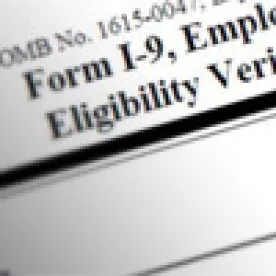Employers preparing for return to in-person work should review any Form I-9 completed during COVID-19. The temporary policies for Form I-9 compliance in effect since March 20, 2020, will expire on August 31. (Temporary Policies Related to COVID-19 | USCIS) Once the temporary policies sunset, employers will have only three business days to complete in-person, physical verification of an employee's identity and employment authorization, which may prove challenging. Employers, however, can begin in-person verification of these documents at any time and should not wait for the remote inspection policy to expire. If an employer becomes the subject of an I-9 audit, and the Form I-9 is not completed properly, fines can add up very quickly, ranging from $573 to $20,130 per violation. (Form I-9 Inspection Overview | ICE)
Current Remote Inspection Flexibility
The temporary policy currently in place allows employers to complete the physical inspection of required identity and employment authorization documents remotely, in order to complete Section 2 of the Form I-9 for any employee hired on or after March 20, 2020, and for any employee whose identity and employment authorization documents must be reverified on or after March 20, 2020. (Temporary Flexibility of Form I-9 Requirements Related to COVID-19 for Remote Employees | USCIS)
Pursuant to DHS and ICE guidance, employers with employees taking "physical proximity precautions" due to COVID-19 (e.g., employees working remote) are NOT required to physically inspect an employee's identity and employment authorization documents and can complete this inspection remotely (e.g., video link, fax, e-mail, etc.). To complete Section 2, employers still must inspect documents within three business days of the date of hire but can note "Remote Inspection Completed on MM/DD/YYYY" in the Additional Information Section and continue to complete the rest of Section 2.
Employers completing the reverification process using the remote inspection guidance also should follow the above instructions to notate Section 2, Additional Information Section. Examples of properly completed Form I-9s following this guidance can be found here: Form I-9 Examples Related to Temporary COVID-19 Policies | USCIS.
ICE requires that employers taking advantage of this remote inspection guidance must maintain written documentation of the remote onboarding and telework policy for each employee covered by this guidance. (DHS announces flexibility in requirements related to Form I-9 compliance | ICE)
This written documentation should be maintained with the employee's Form I-9.
Note that this "remote inspection" flexibility only applies to employers and workplaces that are operating entirely remotely because of COVID-19 precautions. If any employees are physically present at a work location, the remote inspection policy does not apply. Employers who have any employees physically present at a work location on a "regular, consistent, or predictable basis" must return to in-person physical verification of identity and employment eligibility documentation. However, if employers are unable to complete in-person physical verification because an employee is subject to COVID-19 quarantine requirements, DHS will take this into consideration in the event of an I-9 audit.
Return of In-Person, Physical Inspection
Within three business days of the earlier of August 31 or once an employer resumes normal operations, employers must meet with all employees who were onboarded using the remote verification process to complete in-person verification. To properly complete Section 2, employers must inspect the physical documents and should note "COVID-19. Documents physically examined on MM/DD/YYYY by INITIALS" in the Additional Information Section. If the person who inspected the employee documents remotely is NOT the same person who performs the in-person, physical inspection, the employer must note "COVID-19. Documents physically examined on MM/DD/YYYY by [FULL NAME, TITLE]."
Employers should start now to determine which employees were onboarded after March 20, 2020, using remote verification, which employees have returned to the physical worksite on a regular, consistent, or predictable basis, as well as those employees with reverification requirements, in order to ensure the Form I-9 is properly completed. This includes ensuring the current version of Form I-9, dated October 21, 2019, is used. Employers should also seek counsel regarding their current I-9 processes, given the complicated guidance provided by ICE and DHS for completing the Form I-9 during COVID-19.
Consideration of Impact of Collective Bargaining Agreements
Employers working with organized labor forces should also be mindful of recent National Labor Relations Board (NLRB) guidance. On May 26, 2021, the NLRB held that an employer had wrongfully refused to bargain collectively with a union over the effects of the employer's decision to require bargaining unit employees to provide new I-9 forms and supporting documentation. As a result, employers with an organized workforce considering changes to I-9 policies should seek the assistance of an attorney before implementing any changes.
Additional information regarding temporary policies related to the I-9 Form and E-Verify can be found at the following websites:
This information is based on the facts and guidance available at the time of publication and may change.






 />i
/>i

